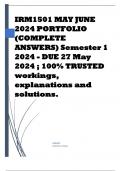IRM1501 MAY JUNE
2024 PORTFOLIO
(COMPLETE
ANSWERS) Semester 1
2024 - DUE 27 May
2024 ; 100% TRUSTED
workings,
explanations and
solutions.
ADMIN
[COMPANY NAME]
, QUESTION 1 The Constitutional Court of South Africa in the case of Sidumo v
Rustenburg Platinum Mines Ltd & Others 2007 12 BLLR 1097 (CC) devised a
new test to be applied when determining the fairness of the dismissal. Discuss
the case of Sidumo in the prescribed format (facts, legal question, reasons for
the decision or ratio decidendi and the findings of the case) and highlight the
test that the Constitutional Court designed in deciding on fairness in labour
law matters. (15 Marks)
Case of Sidumo v Rustenburg Platinum Mines Ltd & Others 2007 12 BLLR 1097
(CC)
1. Facts: Richard Sidumo was employed as a security guard by Rustenburg Platinum
Mines Ltd. His duties included searching employees exiting the premises to prevent
theft. During one of his shifts, Sidumo conducted a search that failed to prevent an
employee from leaving with stolen property. As a result, the company charged him with
negligence and subsequently dismissed him following a disciplinary hearing. Sidumo
challenged his dismissal, arguing it was unfair. The matter proceeded through various
levels of arbitration and judicial review, ultimately reaching the Constitutional Court.
2. Legal Question: The primary legal question was whether Sidumo's dismissal was
substantively fair and, more broadly, what test should be applied by reviewing courts
when assessing the fairness of a dismissal determined by a commissioner in arbitration
proceedings under the Labour Relations Act (LRA).
3. Reasons for the Decision (Ratio Decidendi): The Constitutional Court's reasoning
revolved around the interpretation of Section 145 of the LRA, which addresses the
grounds on which arbitration awards can be reviewed. The Court needed to balance the
deference due to arbitration decisions with the necessity of ensuring fairness in
dismissal disputes.




